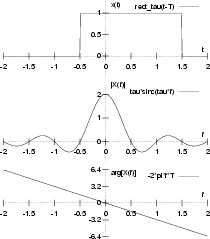Nel caso in cui
x![]() t
t![]() sia reale, risulta3.1
sia reale, risulta3.1
Trasformata ed antitrasformata differiscono solo per il segno. Ciò comporta
che se sostituiamo alla variabile f del risultato
X![]() f
f![]() di una
di una
![]() -trasformata, la variabile t, si ottiene una
funzione del tempo
X
-trasformata, la variabile t, si ottiene una
funzione del tempo
X![]() t
t![]() che, se nuovamente trasformata,
fornisce ... il segnale originario
x
che, se nuovamente trasformata,
fornisce ... il segnale originario
x![]() t
t![]() , calcolato nella
variabile f, cambiata di segno:
x
, calcolato nella
variabile f, cambiata di segno:
x![]() - f
- f![]() . Il concetto
esposto, verificabile analiticamente con facilità, si riassume come
. Il concetto
esposto, verificabile analiticamente con facilità, si riassume come
e consente l'uso di risultati ottenuti ``in un senso'' (ad es. da tempo a frequenza) per derivare senza calcoli i risultati nell'altro (o viceversa).
Supponiamo di voler
![]() -trasformare il segnale
x
-trasformare il segnale
x![]() t
t![]() = B
= B![]() = Bsinc
= Bsinc![]() tB
tB![]() :
l'applicazione cieca dell'integrale che definisce la trasformata di Fourier
appare un'impresa ardua...
:
l'applicazione cieca dell'integrale che definisce la trasformata di Fourier
appare un'impresa ardua...

Discende molto semplicemente dalla proprietà distributiva dell'integrale che definisce la trasformata. Pertanto:
Subito verificabile una volta notato che la
![]() -trasformata,
calcolata per f = 0, si riduce all'integrale di
x
-trasformata,
calcolata per f = 0, si riduce all'integrale di
x![]() t
t![]() ,
e quindi al suo valor medio. Pertanto:
,
e quindi al suo valor medio. Pertanto:
Come esempio di applicazione, troviamo subito che
Si tratta di una proprietà molto semplice, e che ricorre frequentemente nei
calcoli sui segnali. Manifesta la relazione esistente tra la trasformata dei
segnali e quella degli stessi translati, e si esprime con il predicato:
| se | z |
= x |
|
| allora | Z |
= X |

La figura in fondo alla pagina precedente esemplifica il risultato ottenuto
per
x![]() t
t![]() = rect
= rect![]()
![]() t - T
t - T![]() , mostrando come
nello spettro di
x
, mostrando come
nello spettro di
x![]() t
t![]() , di modulo
, di modulo
![]() X
X![]() f
f![]()
![]() =
= ![]()
![]() rect
rect![]()
![]() =
= ![]() sinc
sinc![]() f
f![]()
![]() ,
si aggiunga un contributo di fase lineare
,
si aggiunga un contributo di fase lineare
![]()
![]() f
f![]() = - 2
= - 2![]() fT.
Nel caso in figura, si è posto
fT.
Nel caso in figura, si è posto ![]() = 2 e T = .5, ottenendo in definitiva
Z
= 2 e T = .5, ottenendo in definitiva
Z![]() f
f![]() = X
= X![]() f
f![]() e-j2
e-j2![]() fT = 2sinc
fT = 2sinc![]() 2f
2f![]() e-j2
e-j2![]() f.
f.
Poniamo ora l'attenzione sul fatto che l'espressione
x![]() t - T
t - T![]() indica un ritardo del segnale
x
indica un ritardo del segnale
x![]() t
t![]() di una quantità
pari a T.
di una quantità
pari a T.
La circostanza che questo ritardo si traduca in un andamento lineare della fase3.3 di
X![]() f
f![]() ha una conseguenza notevole anche nell'altra direzione,
ossia:
ha una conseguenza notevole anche nell'altra direzione,
ossia:
Una alterazione della fase di Xf
deve essere lineare in f, se si desidera che il segnale mantenga inalterata la sua forma d'onda.
Consideriamo un segnale periodico
x![]() t
t![]() costituito da due
sole armoniche:
x
costituito da due
sole armoniche:
x![]() t
t![]() = asin
= asin![]()
![]() t
t![]() + bsin
+ bsin![]() 2
2![]() t
t![]() (avendo posto
2
(avendo posto
2![]() F =
F = ![]() ), assieme alla sua versione ritardata
x
), assieme alla sua versione ritardata
x![]() t - T
t - T![]() = asin
= asin![]()
![]()
![]() t - T
t - T![]()
![]() + bsin
+ bsin![]() 2
2![]()
![]() t - T
t - T![]()
![]() = asin
= asin![]()
![]() t -
t - ![]() T
T![]() + bsin
+ bsin![]() 2
2![]() t - 2
t - 2![]() T
T![]() .
Ponendo
.
Ponendo
![]() T =
T = ![]() , otteniamo
x
, otteniamo
x![]() t - T
t - T![]() = asin
= asin![]()
![]() t -
t - ![]()
![]() + bsin
+ bsin![]() 2
2![]() t - 2
t - 2![]()
![]() ,
e verifichiamo che la seconda armonica subisce un ritardo di fase esattamente
doppio.
,
e verifichiamo che la seconda armonica subisce un ritardo di fase esattamente
doppio.
In fig 3.2 si è posto a = 1; b = .5;
E' la proprietà duale della precedente, e stabilisce che
Da un punto di vista pratico, può sorgere qualche perplessità per la comparsa di un segnale complesso nel tempo. Mostriamo però che anti-trasformando uno spettro ottenuto dalla somma di due traslazioni opposte, si ottiene un segnale reale:
![[*]](cross_ref_motif.gif) ).
).
Deriva direttamente dalla definizione di
![]() -trasformata:
-trasformata:
Quantifica gli effetti sullo spettro di una variazione nella velocità di scorrimento del tempo (e viceversa). Possiamo pensare come, riavvolgendo velocemente un nastro magnetico, si ascolta un segnale di durata più breve, e dal timbro più acuto. Questo fenomeno viene espresso analiticamente come:
Prima di continuare ad esporre altre proprietà notevoli della trasformata di
Fourier, occorre definire ed analizzare le proprietà della ``funzione`` impulso
matematico, indicata con
![]() (.).
(.).